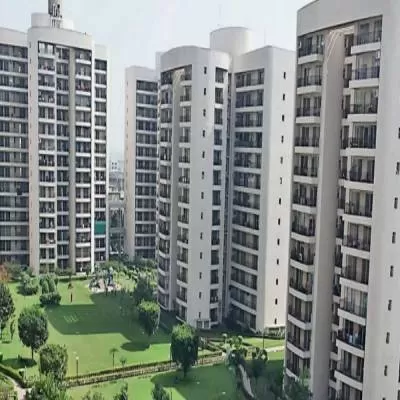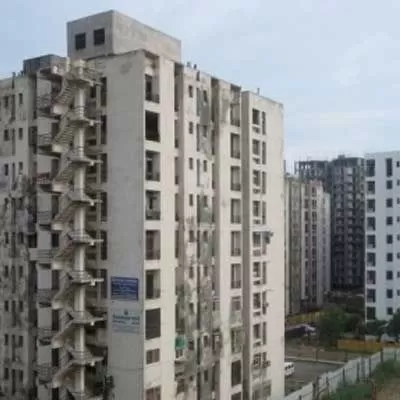- Home
- Real Estate
- Preparing for RERA, Hit by DeMo

Preparing for RERA, Hit by DeMo
India's GDP had touched levels of over 10 per cent in 2009 and 2010. Then, from 2011 onwards, global headwinds began to affect our economy. The year 2012 saw 4-6 per cent growth levels. From 2013 onwards, however, the GDP has grown at 7-8 per cent each quarter, offering a semblance of stability (see chart).
Residential real estate: 2007-16
Reacting to the upswing in the economy, the residential market had attracted a large amount of supply in the 2007-2011 phase - starting with Noida and eventually spreading the cheer across major metros. This market was caught in a huge upstream current as economic growth fell sharply in 2011; however, the momentum of launches took a couple of years to reverse.
The uncontrolled launches also led to widespread project delays, leading to a trust deficit in the market. Prices had increased year-on-year from 2005 to 2012, and looked improbably high in some localities. Coupled with the economic slowdown, these factors led to an exit of investors from this sector; some serious end-users perched themselves on the fence, waiting for 'prices to correct'.
As a consequence, sales of residential apartments in the top nine cities started plummeting from 460,000 units in FY14 and 310,000 in FY15 to 210,000 in FY16 (according to the PropTiger DataLabs Realty Decoded Report).
The good news in FY16 was that the 210,000 units sold were more or less equally spread out across the four quarters. This meant that the market had found its bottom, and sales were no longer falling quarter on quarter, which was the case for three years before that. This came as a sign of relief for the industry. It seemed that this was the minimum number of new homes required in the top nine cities of India, and this was the worst-case demand in the sector.
2017: Signs of revival; waiting for RERA
This level of sales of 50,000-55,000 units per quarter continued in Q1 and Q2 of FY17 also. In fact, it had been six straight quarters of such a level of sales. Four more positive factors had started impacting the environment. Prime Minister Narendra Modi's programmes of economic reforms implemented since May 2014 started showing some results.
The US economy's positive performance had started pulling the global economy out of its doldrums. Prices of residential apartments had remained stagnant from 2013 onwards, implying a real fall in prices, after deducting annual inflation. Finally, the industry was preparing for RERA to be implemented, which would clean up the sector from false promises and restore faith in consumers. All these factors manifested themselves from July to October 2016, showing month-on-month increase in enquiries and sales of apartments. In fact, 21,000 units were sold in October 2016 alone, one of the highest sales in any month in the previous two years. It looked like Q3 would end up with over 60,000 units sold, and that the market was growing again.
Demonetisation
On November 8, 2016, the prime minister implemented one of the most forward-looking reforms, with the objective of cleaning out a significant part of black money from the country. This was demonetisation (DeMo), under which currency notes of Rs 500 and Rs 1,000 were declared invalid overnight. They were to be replaced with new notes of Rs 2,000 and Rs 500 in the next three to four months. Stock analysts predicted that real-estate prices would fall by 30 per cent, taking into account the presence of cash in some transactions in real estate.
End-users started waiting for this price fall to happen, and sale of residential units fell by 50 per cent in November and December.
On January 1, 2017, the prime minister announced a fall in home loan rates, and various incentives to developers and buyers for affordable housing. This improved the sentiment a little. By this time, end-users had also realised that expecting any huge price drop was an unrealistic pipedream, given that prices had already fallen in real terms from 2013 onwards.
As a result, they started buying apartments again. The prospect of RERA implementation being real and around the corner also started giving consumers more confidence. Consequently, Q4FY17 saw a bounce back in sales compared to Q3, to return to pre-DeMo levels.
Other trends
Sales of apartments in the sub-Rs 50 lakh segment have gone up to 54 per cent in Q3FY17 and 58 per cent in Q4FY17, from a stable level of 51-52 per cent in the previous six quarters. This is coming on the back of the sops announced for the affordable segment.
National average prices have remained flat over the past 12 months. However, the national average hides a smart 5 per cent increase in prices in Hyderabad, and 3 per cent each in Bengaluru and Chennai. Prices in other large cities have remained flat to having fallen by 3 per cent!
The way forward
The provisions of RERA are designed to protect end-consumers and the key protective clauses are:
- Projects cannot be marketed without a minimum set of approvals (there is little risk now of buying a project with no approvals).
- Project plans cannot be changed for five years without approval of buyers (thereby effecting 'what you bought is what you got').
- Project marketing to specify clearly the features of units - carpet area, parking spaces, etc.
- Project completion date to be specified by the developer and penal interest to be paid to the consumer in case of delays.
- Funds for a project to be used only for that project (by keeping 70 per cent in escrow).
With DeMo having cleaned out the sector of the cash transactions that were taking place and RERA setting up a consumer-friendly environment, the residential sector is set to bounce back smartly in coming years. In three to four quarters, with the supply-demand equation becoming rebalanced, prices will also start increasing realistically. At the same time, equity markets have heated up considerably, with the SENSEX being at an all-time high. This confluence of factors may also bring back the investor community into the real-estate asset class. While we do not see the pricing euphoria of 2004-2011 coming back again, this sector will start behaving like a mature, positive sector and will soon become a viable investment alternative.
There will also be an increase in end-user demand from the current low levels of 210,000 units a year to much higher numbers. With increasing urbanisation and nuclearisation of families, there is demand for 88 million homes over the next 10 years. Indeed, the positive part of the business cycle has begun. End-users must stop waiting and investors need to start building their portfolios in a smart way.
About the author:
Sunil Mishra is the Group Chief Strategy Officer of Housing.com, PropTiger.com and Makaan.com.
To share your views on this article, write in at feedback@ConstructionWorld.in
SUNIL MISHRA reviews the real-estate sector in FY2016-17 considering key parameters that have had a tremendous impact on the sector in the past five years. India's GDP had touched levels of over 10 per cent in 2009 and 2010. Then, from 2011 onwards, global headwinds began to affect our economy. The year 2012 saw 4-6 per cent growth levels. From 2013 onwards, however, the GDP has grown at 7-8 per cent each quarter, offering a semblance of stability (see chart). Residential real estate: 2007-16 Reacting to the upswing in the economy, the residential market had attracted a large amount of supply in the 2007-2011 phase - starting with Noida and eventually spreading the cheer across major metros. This market was caught in a huge upstream current as economic growth fell sharply in 2011; however, the momentum of launches took a couple of years to reverse. The uncontrolled launches also led to widespread project delays, leading to a trust deficit in the market. Prices had increased year-on-year from 2005 to 2012, and looked improbably high in some localities. Coupled with the economic slowdown, these factors led to an exit of investors from this sector; some serious end-users perched themselves on the fence, waiting for 'prices to correct'. As a consequence, sales of residential apartments in the top nine cities started plummeting from 460,000 units in FY14 and 310,000 in FY15 to 210,000 in FY16 (according to the PropTiger DataLabs Realty Decoded Report). The good news in FY16 was that the 210,000 units sold were more or less equally spread out across the four quarters. This meant that the market had found its bottom, and sales were no longer falling quarter on quarter, which was the case for three years before that. This came as a sign of relief for the industry. It seemed that this was the minimum number of new homes required in the top nine cities of India, and this was the worst-case demand in the sector. 2017: Signs of revival; waiting for RERA This level of sales of 50,000-55,000 units per quarter continued in Q1 and Q2 of FY17 also. In fact, it had been six straight quarters of such a level of sales. Four more positive factors had started impacting the environment. Prime Minister Narendra Modi's programmes of economic reforms implemented since May 2014 started showing some results. The US economy's positive performance had started pulling the global economy out of its doldrums. Prices of residential apartments had remained stagnant from 2013 onwards, implying a real fall in prices, after deducting annual inflation. Finally, the industry was preparing for RERA to be implemented, which would clean up the sector from false promises and restore faith in consumers. All these factors manifested themselves from July to October 2016, showing month-on-month increase in enquiries and sales of apartments. In fact, 21,000 units were sold in October 2016 alone, one of the highest sales in any month in the previous two years. It looked like Q3 would end up with over 60,000 units sold, and that the market was growing again. Demonetisation On November 8, 2016, the prime minister implemented one of the most forward-looking reforms, with the objective of cleaning out a significant part of black money from the country. This was demonetisation (DeMo), under which currency notes of Rs 500 and Rs 1,000 were declared invalid overnight. They were to be replaced with new notes of Rs 2,000 and Rs 500 in the next three to four months. Stock analysts predicted that real-estate prices would fall by 30 per cent, taking into account the presence of cash in some transactions in real estate. End-users started waiting for this price fall to happen, and sale of residential units fell by 50 per cent in November and December. On January 1, 2017, the prime minister announced a fall in home loan rates, and various incentives to developers and buyers for affordable housing. This improved the sentiment a little. By this time, end-users had also realised that expecting any huge price drop was an unrealistic pipedream, given that prices had already fallen in real terms from 2013 onwards. As a result, they started buying apartments again. The prospect of RERA implementation being real and around the corner also started giving consumers more confidence. Consequently, Q4FY17 saw a bounce back in sales compared to Q3, to return to pre-DeMo levels. Other trends Sales of apartments in the sub-Rs 50 lakh segment have gone up to 54 per cent in Q3FY17 and 58 per cent in Q4FY17, from a stable level of 51-52 per cent in the previous six quarters. This is coming on the back of the sops announced for the affordable segment. National average prices have remained flat over the past 12 months. However, the national average hides a smart 5 per cent increase in prices in Hyderabad, and 3 per cent each in Bengaluru and Chennai. Prices in other large cities have remained flat to having fallen by 3 per cent! The way forward The provisions of RERA are designed to protect end-consumers and the key protective clauses are: Projects cannot be marketed without a minimum set of approvals (there is little risk now of buying a project with no approvals). Project plans cannot be changed for five years without approval of buyers (thereby effecting 'what you bought is what you got'). Project marketing to specify clearly the features of units - carpet area, parking spaces, etc. Project completion date to be specified by the developer and penal interest to be paid to the consumer in case of delays. Funds for a project to be used only for that project (by keeping 70 per cent in escrow). With DeMo having cleaned out the sector of the cash transactions that were taking place and RERA setting up a consumer-friendly environment, the residential sector is set to bounce back smartly in coming years. In three to four quarters, with the supply-demand equation becoming rebalanced, prices will also start increasing realistically. At the same time, equity markets have heated up considerably, with the SENSEX being at an all-time high. This confluence of factors may also bring back the investor community into the real-estate asset class. While we do not see the pricing euphoria of 2004-2011 coming back again, this sector will start behaving like a mature, positive sector and will soon become a viable investment alternative. There will also be an increase in end-user demand from the current low levels of 210,000 units a year to much higher numbers. With increasing urbanisation and nuclearisation of families, there is demand for 88 million homes over the next 10 years. Indeed, the positive part of the business cycle has begun. End-users must stop waiting and investors need to start building their portfolios in a smart way. About the author: Sunil Mishra is the Group Chief Strategy Officer of Housing.com, PropTiger.com and Makaan.com. To share your views on this article, write in at feedback@ConstructionWorld.in




















